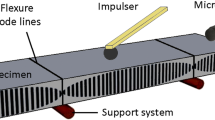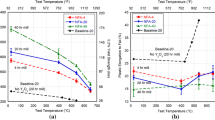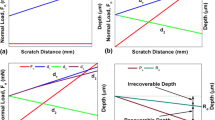Abstract
The effect of particle distribution non-uniformity on the microstructure and flow stress in nanostructured metal matrix composites produced by severe plastic deformation was investigated. The Al/SiC composite fabricated by accumulative roll bonding was considered as a case. Transmission electron microscope (TEM) and scanning transmission electron microscope (STEM) were used for microstructural characterizations. Based on the particle distribution, three different zones were considered: particle-free zone, single particle zone, and cluster zone. In comparison to the particle free zone, finer grain sizes with higher boundary misorientation angle were observed in the single particle zone. The lowest grain size (342/260 nm by TEM/STEM) was obtained in the cluster zone approximately between two near particles. The selected area diffraction showed the highest misorientation angle at these regions. A combined microstructure strengthening analysis was considered for the prediction of the flow stress. The flow stress is predicted based on the grain sizes at various microstructural zones, and the results were compared with the experimental yield stress of the composite.






Similar content being viewed by others
References
Lloyd DJ (1994) Particle reinforced aluminium and magnesium matrix composites. Int Mater Rev 39(1):1–23. doi:10.1179/imr.1994.39.1.1
Ibrahim IA, Mohamed FA, Lavernia EJ (1991) Particulate reinforced metal matrix composites—a review. J Mater Sci 26(5):1137–1156. doi:10.1007/bf00544448
Xu W, Ma H, Ji S, Chen H (2016) Analytical effective elastic properties of particulate composites with soft interfaces around anisotropic particles. Compos Sci Technol 129:10–18. doi:10.1016/j.compscitech.2016.04.011
Sun CJ, Saffari P, Sadeghipour K, Baran G (2005) Effects of particle arrangement on stress concentrations in composites. Mater Sci Eng 405(1–2):287–295. doi:10.1016/j.msea.2005.06.032
Ekici R, Kemal Apalak M, Yıldırım M, Nair F (2010) Effects of random particle dispersion and size on the indentation behavior of SiC particle reinforced metal matrix composites. Mater Des 31(6):2818–2833. doi:10.1016/j.matdes.2010.01.001
Bie BX, Huang JY, Su B, Lu L, Fan D, JC E, Sun T, Fezzaa K, Qi ML, Luo SN (2016) Dynamic tensile deformation and damage of B4C-reinforced Al composites: time-resolved imaging with synchrotron x-rays. Mater Sci Eng 664:86–93. doi:10.1016/j.msea.2016.03.124
Sabirov I, Kolednik O (2005) The effect of inclusion size on the local conditions for void nucleation near a crack tip in a mild steel. Scr Mater 53(12):1373–1378. doi:10.1016/j.scriptamat.2005.08.027
Sabirov I, Duschlbauer D, Pettermann HE, Kolednik O (2005) The determination of the local conditions for void initiation in front of a crack tip for materials with second-phase particles. Mater Sci Eng 393(1–2):275–285. doi:10.1016/j.msea.2004.10.013
Heinrich H, Vananti A, Kostorz G (2001) Strain fields at interfaces of Al-based metal matrix composites. Mater Sci Eng 319–321:434–438. doi:10.1016/S0921-5093(01)00955-8
Douin J, Donnadieu P, Houdellier F (2010) Elastic strain around needle-shaped particles embedded in Al matrix. Acta Mater 58(17):5782–5788. doi:10.1016/j.actamat.2010.06.053
Yuan MN, Yang YQ, Li C, Heng PY, Li LZ (2012) Numerical analysis of the stress–strain distributions in the particle reinforced metal matrix composite SiC/6064Al. Mater Des 38:1–6. doi:10.1016/j.matdes.2011.12.043
Chawla N, Chawla KK (2006) Microstructure-based modeling of the deformation behavior of particle reinforced metal matrix composites. J Mater Sci 41(3):913–925. doi:10.1007/s10853-006-6572-1
Sabirov I, Kolednik O, Valiev RZ, Pippan R (2005) Equal channel angular pressing of metal matrix composites: effect on particle distribution and fracture toughness. Acta Mater 53(18):4919–4930. doi:10.1016/j.actamat.2005.07.010
Wu X, Xia K (2007) Back pressure equal channel angular consolidation—application in producing aluminium matrix composites with fine flyash particles. J Mater Process Technol 192–193:355–359. doi:10.1016/j.jmatprotec.2007.04.007
Sabbaghianrad S, Langdon TG (2016) Developing superplasticity in an aluminum matrix composite processed by high-pressure torsion. Mater Sci Eng 655:36–43. doi:10.1016/j.msea.2015.12.078
Alhajeri SN, Al-Fadhalah KJ, Almazrouee AI, Langdon TG (2016) Microstructure and microhardness of an Al-6061 metal matrix composite processed by high-pressure torsion. Mater Charact 118:270–278. doi:10.1016/j.matchar.2016.06.003
Reihanian M, Jalili Shahmansouri M, Khorasanian M (2015) High strength Al with uniformly distributed Al2O3 fragments fabricated by accumulative roll bonding and plasma electrolytic oxidation. Mater Sci Eng 640:195–199. doi:10.1016/j.msea.2015.05.104
Reihanian M, Hadadian FK, Paydar MH (2014) Fabrication of Al–2 vol% Al2O3/SiC hybrid composite via accumulative roll bonding (ARB): an investigation of the microstructure and mechanical properties. Mater Sci Eng 607:188–196. doi:10.1016/j.msea.2014.04.013
Daneshvar F, Reihanian M, Gheisari K (2016) Al-based magnetic composites produced by accumulative roll bonding (ARB). Mater Sci Eng 206:45–54. doi:10.1016/j.mseb.2016.01.003
Valiev RZ, Islamgaliev RK, Alexandrov IV (2000) Bulk nanostructured materials from severe plastic deformation. Prog Mater Sci 45(2):103–189. doi:10.1016/S0079-6425(99)00007-9
Meyers MA, Mishra A, Benson DJ (2006) Mechanical properties of nanocrystalline materials. Prog Mater Sci 51(4):427–556. doi:10.1016/j.pmatsci.2005.08.003
Schmidt CW, Knieke C, Maier V, Höppel HW, Peukert W, Göken M (2011) Accelerated grain refinement during accumulative roll bonding by nanoparticle reinforcement. Scr Mater 64(3):245–248. doi:10.1016/j.scriptamat.2010.10.013
Jamaati R, Toroghinejad MR (2010) Application of ARB process for manufacturing high-strength, finely dispersed and highly uniform Cu/Al2O3 composite. Mater Sci Eng 527(27–28):7430–7435. doi:10.1016/j.msea.2010.08.038
Yazdani A, Salahinejad E (2011) Evolution of reinforcement distribution in Al–B4C composites during accumulative roll bonding. Mater Des 32(6):3137–3142. doi:10.1016/j.matdes.2011.02.063
Rezayat M, Akbarzadeh A, Owhadi A (2012) Fabrication of high-strength Al/SiC p nanocomposite sheets by accumulative roll bonding. Metall Mater Trans A 43(6):2085–2093. doi:10.1007/s11661-011-1039-7
Jamaati R, Toroghinejad MR, Edris H (2014) Effect of SiC nanoparticles on the mechanical properties of steel-based nanocomposite produced by accumulative roll bonding process. Mater Des 54:168–173. doi:10.1016/j.matdes.2013.08.033
Alizadeh M (2010) Comparison of nanostructured Al/B4C composite produced by ARB and Al/B4C composite produced by RRB process. Mater Sci Eng 528(2):578–582. doi:10.1016/j.msea.2010.08.093
Alizadeh M, Paydar MH, Terada D, Tsuji N (2012) Effect of SiC particles on the microstructure evolution and mechanical properties of aluminum during ARB process. Mater Sci Eng 540:13–23. doi:10.1016/j.msea.2011.12.026
Alizadeh M, Paydar MH (2010) Fabrication of nanostructure Al/SiCP composite by accumulative roll-bonding (ARB) process. J Alloy Compd 492(1–2):231–235. doi:10.1016/j.jallcom.2009.12.026
Saito Y, Utsunomiya H, Tsuji N, Sakai T (1999) Novel ultra-high straining process for bulk materials—development of the accumulative roll-bonding (ARB) process. Acta Mater 47(2):579–583. doi:10.1016/S1359-6454(98)00365-6
Saito Y, Tsuji N, Utsunomiya H, Sakai T, Hong RG (1998) Ultra-fine grained bulk aluminum produced by accumulative roll-bonding (ARB) process. Scr Mater 39(9):1221–1227. doi:10.1016/S1359-6462(98)00302-9
Reihanian M, Bagherpour E, Paydar MH (2013) On the achievement of uniform particle distribution in metal matrix composites fabricated by accumulative roll bonding. Mater Lett 91:59–62. doi:10.1016/j.matlet.2012.09.043
Courtney TH (2000) Mechanical behavior of materials. McGraw Hill, Boston, pp 212–218
Nardone VC, Prewo KM (1986) On the strength of discontinuous silicon carbide reinforced aluminum composites. Scr Metall 20(1):43–48. doi:10.1016/0036-9748(86)90210-3
Sekine H, Chent R (1995) A combined microstructure strengthening analysis of SiCp/Al metal matrix composites. Composites 26(3):183–188. doi:10.1016/0010-4361(95)91381-E
Arsenault RJ, Shi N (1986) Proceedings of the international conference on low energy dislocation structures dislocation generation due to differences between the coefficients of thermal expansion. Mater Sci Eng 81:175–187. doi:10.1016/0025-5416(86)90261-2
Hansen N (2004) Hall–Petch relation and boundary strengthening. Scr Mater 51(8):801–806. doi:10.1016/j.scriptamat.2004.06.002
Ashby MF (1966) Work hardening of dispersion-hardened crystals. Philos Mag 14(132):1157–1178. doi:10.1080/14786436608224282
Fleck NA, Ashby MF, Hutchinson JW (2003) The role of geometrically necessary dislocations in giving material strengthening. Scr Mater 48(2):179–183. doi:10.1016/S1359-6462(02)00338-X
Ferguson JB, Lopez H, Kongshaug D, Schultz B, Rohatgi P (2012) Revised Orowan strengthening: effective interparticle spacing and strain field considerations. Metall Mater Trans A 43(6):2110–2115. doi:10.1007/s11661-011-1029-9
Zhang Z, Chen DL (2006) Consideration of Orowan strengthening effect in particulate-reinforced metal matrix nanocomposites: a model for predicting their yield strength. Scr Mater 54(7):1321–1326. doi:10.1016/j.scriptamat.2005.12.017
Bay B, Hansen N, Hughes DA, Kuhlmann-Wilsdorf D (1992) Overview no. 96 evolution of f.c.c. deformation structures in polyslip. Acta Metall Mater 40(2):205–219. doi:10.1016/0956-7151(92)90296-Q
Hughes DA, Hansen N (1997) High angle boundaries formed by grain subdivision mechanisms. Acta Mater 45(9):3871–3886. doi:10.1016/S1359-6454(97)00027-X
Kuhlmann-Wilsdorf D, Hansen N (1991) Geometrically necessary, incidental and subgrain boundaries. Scr Metall Mater 25(7):1557–1562. doi:10.1016/0956-716X(91)90451-6
Acknowledgements
Financial support provided by Shahid Chamran University of Ahvaz (Grant No. 94-3-02-31579) is gratefully acknowledged. Also, E. Bagherpour acknowledges the financial support of the Metallic Materials Science Laboratory of Doshisha University for the application of electron microscopes.
Author information
Authors and Affiliations
Corresponding author
Rights and permissions
About this article
Cite this article
Bagherpour, E., Reihanian, M. & Miyamoto, H. Tailoring particle distribution non-uniformity and grain refinement in nanostructured metal matrix composites fabricated by severe plastic deformation (SPD): a correlation with flow stress. J Mater Sci 52, 3436–3446 (2017). https://doi.org/10.1007/s10853-016-0632-y
Received:
Accepted:
Published:
Issue Date:
DOI: https://doi.org/10.1007/s10853-016-0632-y




